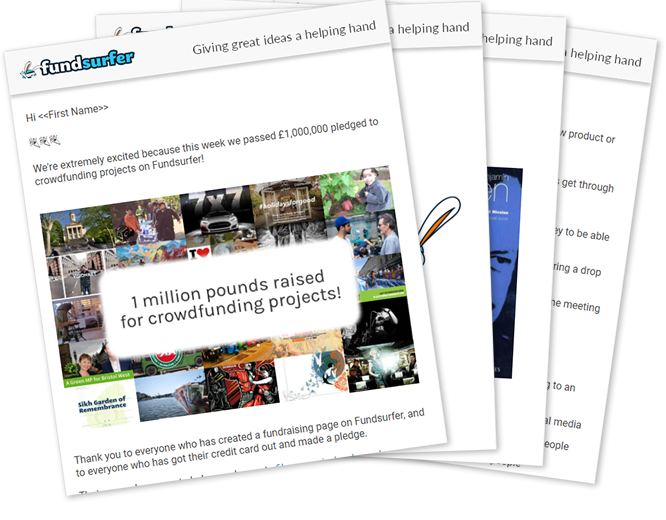
How to raise funds for business and creative projects: strategies and trends
August 2024
Funding is the lifeblood of any venture—whether it’s a startup, small business, or creative project. But the path to securing capital can feel daunting, especially with the myriad options available today. From crowdfunding to venture capital, loans to grants, it’s essential to choose the right method for your project and audience. Understanding what is a good option for your company and how to access funding is key to growth.
At Fundsurfer, we’ve helped 100's of clients like you successfully raise the capital they need to really get their business going.
In this article, we’ll dive into some of the key strategies and discuss the trends that are shaping the funding landscape in 2024.
1. Understanding Your Funding Options
Before you dive into fundraising, it’s important to understand the landscape. Here are some of the most popular funding methods for businesses and creative projects:
Crowdfunding: A popular choice for both entrepreneurs and creatives, crowdfunding allows you to tap into a large pool of small contributions from individuals.
Grants and Loans: Government bodies, such as Innovate UK, Social Investment Business or the British Business Bank, offer grants or loans that don’t require giving up equity. For creative projects, organisations like Creative England and Arts Council England also provide support. Grants and Loan options are also ideal for businesses that meet specific criteria or are working on socially impactful projects.
Angel Investors and Venture Capital (VC): Angel investors and VCs are individuals or firms that provide significant capital in exchange for equity in your business. This method works best for businesses with high growth potential, but it often requires a strong track record or compelling proof of concept. You also have to be fairly resilient and persistent to succeed as you may have to pitch 50 or more investors!
Family, Friends, and Personal Savings: While less formal, many startups are bootstrapped by borrowing from personal networks or dipping into savings. This can be a good first step, especially if external funding isn’t immediately available.
2. Crowdfunding for Creative and Business Projects
Crowdfunding has democratised the way individuals and businesses can raise funds, making it accessible to almost anyone with a compelling idea. However, succeeding in crowdfunding isn’t just about putting up a campaign and waiting for the money to roll in. It requires strategy, storytelling, and engagement with your community.
Here are three key tips to run a successful crowdfunding campaign:
Tell a Compelling Story: People are more likely to fund something that emotionally resonates with them. For creative projects, this often means sharing your personal journey and vision. For businesses, it means showcasing the impact of your product or service and how it solves a real problem. It's really important you nail down your story and present it. Be bold, articulate your vision and have fun!
Set Realistic Goals and Rewards: Your funding goal should be achievable and based on a solid budget. Likewise, rewards should be attractive but realistic—many campaigns fail because the creators overpromise and underdeliver. Whether it's offering early access to your product or exclusive perks for backers, make sure you balance value with feasibility. Remember all rewards have a fulfilment cost, make sure you factor those costs in!
Leverage Social Proof: Success breeds success. When people see that others are backing your campaign, they’re more likely to join in. Start by reaching out to your personal network to get the initial momentum. Use social media to build buzz and keep backers updated on your progress throughout the campaign.
3. Industry Trends Shaping the Future of Fundraising
The fundraising landscape is constantly evolving, and keeping an eye on emerging trends can give you an edge in securing capital. Here are a few key trends shaping the way businesses and creatives will raise funds in 2024 and beyond:
Sustainable and Impact Investment: There’s a growing focus on sustainability and social impact in the investment community. Investors are increasingly looking to fund projects that not only provide financial returns but also make a positive contribution to society or the environment. Companies that prioritize ESG (Environmental, Social, and Governance) principles are seeing more opportunities to raise capital, whether through grants, impact investors, or specialised funds.
Digital and Decentralised Finance: Blockchain technology and decentralised finance (DeFi) are creating new ways for businesses to raise funds. Tokenisation, for example, allows businesses to issue digital tokens in exchange for investment, offering an alternative to traditional shares. While still in its early stages, this trend is expected to grow as blockchain adoption increases. Adoption of Bitcoin is happening at a very dramatic rate and we project that to continue gathering momentum.
Government and Institutional Support: Governments worldwide are recognising the importance of supporting small businesses and innovation. In the UK, programs from Innovate UK and UK Export Finance are providing significant resources to businesses, from grants and loans to access to global markets.
5. Preparing Your Business or Creative Project for Fundraising
Securing funding, no matter the method, requires preparation. Investors and backers need to believe in your vision and see that you have a clear plan for how their money will be used.
Here are some key steps to prepare for fundraising:
Develop a Solid Business Plan: Whether you’re raising funds for a business or a creative project, a detailed business plan or project outline is essential. It should clearly explain your goals, the market or audience, and how you plan to achieve success. Don't forget to be clear around your investor 'ask' and also what you are offering in return for investment.
Polish Your Pitch: A great idea isn’t enough—you need to be able to sell it. Practice delivering a compelling pitch that explains what makes your project unique, why it matters, and why it’s worth supporting. Practise makes perfect!
Build an Engaged Audience: Especially for crowdfunding but something often neglected by companies raising investment is to spend some time on building a network of support - having a community of engaged and warm supporters ready to back you can make or break your campaign. Start building your audience long before you begin fundraising by engaging with them through social media, newsletters, or events.
Conclusion
Raising funds for your business or creative project can be challenging, but with the right strategy, preparation, and understanding of the current landscape, success is within reach. Whether you choose to pursue crowdfunding, equity investment, or debt financing, remember that storytelling, community engagement, and clear communication are key to convincing people to invest in your vision.
At Fundsurfer, we’re here to support you every step of the way, with access to a variety of funding options and expert guidance. Ready to start your fundraising journey? Explore our platform and discover the right path for your project today.
Stay up to date

Get our occasional newsletter featuring fundraising news, hints and tips, and our favourite projects




